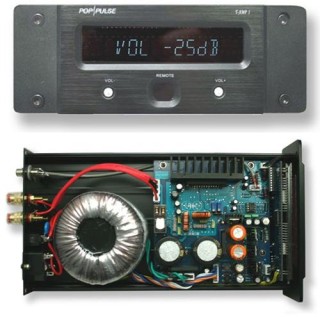- Manufacturer: TOA Corporation
- Designer: Shin Azumi
- Material: ASA resin, nylon
- Dimensions: 27 × 15 × 25
- www.toa.jp

Index
- Megaphone A megaphone, speaking-trumpet, bullhorn, blowhorn, or loud hailer is a portable, usually hand-held, funnel cone-shaped device whose application is to
- Shin Azumi Born in 1965, Kobe, Japan, Shin Azumi studied Product Design at Kyoto City University of Art, Japan and at the Royal College of Art. From 1995 to 2004
- TOA Electronics The TOA Corporation is a Japanese electronics company wich works on the development, manufacturing and distribution of audio and security products. Th
- Materials Horn: Acrylonitrile Styrene Acrylate (ASA) Acrylonitrile Styrene Acrylate (ASA) is produced by introducing a grafted acrylic ester elastomer during th
- History Athanasius Kircher Athanasius Kircher (1908 Germany - 1680 Italy) was a 17th century German Jesuit scholar who published around 40 works, most notabl
- Sound Sound is a travelling wave which is an oscillation of pressure transmitted through a solid, liquid, or gas, composed of frequencies within the range o
- Amplifiers An amplifier or simply amp, is any device that changes, usually increases, the amplitude of a signal. The relationship of the input to the output of a
- Applications Protest Police Lifeguard Sports Concerts
A megaphone, speaking-trumpet, bullhorn, blowhorn, or loud hailer is a portable, usually hand-held, funnel cone-shaped device whose application is to amplify a person's voice towards a targeted direction. This is accomplished by channeling the sound through a funnel, which also serves to match the acoustic impedance of the voice cords to the air. The natural human voice tends to spread evenly in all directions, whereas when it is sent through a megaphone, the sound is concentrated in a given direction and the coupling of its energy to the air optimised. The trade-off is that if a listener is to the side, it is more difficult to hear what is being said. An electronic megaphone amplifies sound to a higher decibel level. It consists of a microphone, an amplifier and a loudspeaker. Common uses for megaphones are at sporting events, political functions, and generally when one needs to address congregations of people in open spaces.
Though some instrument of the kind appears to have been in earlier use, the origin of the megaphone, or speaking trumpet as it was called, is connected with the name of Athanasius Kircher and that of Sir Samuel Morland, who in 1670 proposed to the Royal Society of London the question of the best form for a speaking trumpet. Johann Heinrich Lambert, in the Berlin Memoirs for 1763, seems to have been the first to give a theory of the action of this instrument, based on an altogether imaginary analogy with the behaviour of light.
ER-1206W
The ER-1206W is a compact splash-proof megaphone rated at 6 W output featuring a built-in whistle. It
features IPX5 water-jet-resistant designs. A whistle tone can be used for attracting attention. It operates
with 6 R6P batteries, or 4 R6P batteries when the battery spacer (accessory) is used. Handle and micro-
phone with anti-bacterial treatment improve hygiene and safety during use.
Born in 1965, Kobe, Japan, Shin Azumi studied Product Design at Kyoto City University of Art, Japan and at the Royal College of Art. From 1995 to 2004 he worked as the design unit AZUMI. In 2005 he founded his own studio, a studio.
Shin Azumi work is represented in permanent collections of - Victoria & Albert Museum (UK), Stedelijk Museum (Holland), Crafts Council (UK), Die Neue Sammlung (Germany), Museum fur Angewandte Kunst Frankfurt (Germany).
The TOA Corporation is a Japanese electronics company wich works on the development, manufacturing and distribution of audio and security products. They started operating in 1934 in Kobe, Japan, and were incorporated in 1949. TOA is the company which developed the megaphone or bullhorn known as a loudhailer in 1954 for the first time in the world.
TOA operates in over 100 countries worldwide, with more than 1500 employees and sales greater than $300 million dollars.TOA's extensive line of audio products includes amplifiers, speakers, mixers, wireless microphone systems, digital processors and network audio. Security products include CCTV cameras, DVR's and integrated intercom systems used in security and communications applications.
TOA built the basics of this business in a microphone device for electioneering and afterwards. Above all, it is said that the marketshare of the broadcasting equipment for all current Japanese Airport Facilities exceeds 90%.
Horn: Acrylonitrile Styrene Acrylate (ASA)
Acrylonitrile Styrene Acrylate (ASA) is produced by introducing a grafted acrylic ester elastomer during the copolymerization reaction between styrene and acrylonitrile. Acrylonitrile styrene acrylate material has great toughness and rigidity, good chemical resistance and thermal stability, outstanding resistance to weather, aging and yellowing, and high gloss.
Strap: Nylon
Nylon is a generic designation for a family of synthetic polymers known generically as polyamides and first produced on February 28, 1935 by Wallace Carothers at DuPont. It is one of the most commonly used polymers.
Nylon is a thermoplastic silky material, first used commercially in a nylon-bristled toothbrush (1938), followed more famously by women's stockings ("nylons"; 1940). It is made of repeating units linked by peptide bonds (another name for amide bonds) and is frequently referred to as polyamide (PA). Nylon was the first commercially successful synthetic polymer. There are two common methods of making nylon for fiber applications. In one approach, molecules with an acid (COOH) group on each end are reacted with molecules containing amine (NH2) groups on each end. The resulting nylon is named on the basis of the number of carbon atoms separating the two acid groups and the two amines. These are formed into monomers of intermediate molecular weight, which are then reacted to form long polymer chains.
Nylon was intended to be a synthetic replacement for silk and substituted for it in many different products after silk became scarce during World War II. It replaced silk in military applications such as parachutes and flak vests, and was used in many types of vehicle tires. (...)
Athanasius Kircher
Athanasius Kircher (1908 Germany - 1680 Italy) was a 17th century German Jesuit scholar who published around 40 works, most notably in the fields of oriental studies, geology, and medicine. Kircher has been compared to fellow Jesuit Roger Boscovich and to Leonardo da Vinci for his enormous range of interests, and has been honoured with the title "master of a hundred arts".
Kircher's work with geology included studies of volcanos and fossils. One of the first people to observe microbes through a microscope, he was thus ahead of his time in proposing that the plague was caused by an infectious microorganism and in suggesting effective measures to prevent the spread of the disease. Kircher also displayed a keen interest in technology and mechanical inventions, and inventions attributed to him include a magnetic clock, various automatons and the first megaphone.
Kircher definition of sound is based on Aristotle (384 BC – 322 BC) and Boezio (480–524). Aristotle defined sound as a determined movement from two bodies, wich crash one against the other; Boezio, similarly believed that the sound was a movement, wich broke up the air and afterwards reached the ear.
For Kircher, however, the sound was not simply a physical phenomenom, as it was for the two aforementioned authors, but also that was deeply connected with human nature. Kircher's conception of sound was not yet influenced by the modern theory of oscillations, wich was formulated later thanks to the researchers of Galilei (1564-1642) and Newton (1643-1727), but it already considered the deep relationship between the number of oscilations (frequency) and the pitch of sound.

Phonurgia Nova
Athanasius Kircher is the author of "Phonurgia Nova", a book written in 1673 wich title means " a new method of sound production". The book is subdivided in two books: Phonosophia Nova and Phonosophia Anacamptica, in the second one, Kircher analysed the phenomenom of echo, wich he considered as founded on sound waves, wich, after having hit some "objecta phonocamptica", or "obstacles", they propagated in the air or in the water and therefore producing reverberation. In this book he deals with sound wich propagates in tubes of various shapes and typologies, of sound strengthened in natural caes reemerging at the surface with increased force, about how to listen to other people's conservations while remaining in a concealed room, with the aid of tubes and hidden devices, and how to exchange coded messages by the use of special trumpets.

- 2.bp.blogspot.com/_cDfM7z6mNCA/SnNkNZpP3ZI/AAAAAAAABhw/JReUDg5rdgI/s400/kircher_sound_amplifier.jpg
- intellagence.eu.com/acoustics2008/acoustics2008/cd1/data/articles/000807.pdf
- www.sil.si.edu/digitalcollections/hst/scientific-identity/fullsize/SIL14-K002-02a.jpg
Samuel Morland
Sir Samuel Morland (1625 – 1695), was a notable English academic, diplomat, spy, inventor and mathematician of the 17th century, a polymath credited with early developments in relation to computing, hydraulics and steam power.
The son of Thomas Morland, the rector of Sulhamstead Bannister parish church in Berkshire, he was educated at Winchester School and Magdalene College, Cambridge, where he became a Fellow in 1649.Devoting much time to the study of mathematics, Morland also became an accomplished Latinist and was proficient in Greek, Hebrew and French – then the language of culture and diplomacy. While a tutor at Cambridge, he first encountered Samuel Pepys who became a lifelong acquaintance.
in 1671 he claimed credit for inventing the speaking trumpet, an early form of megaphone.

Samuel Morland Speaking Trumpet
The invention of the speakingtrumpet has been demanded for many; but without inquiring into the validity of their various claims, it is certain that we are indebted to Sir Samuel Morland for the instrument in its present state.
In 1672, Sir Samuel published a description of the speaking-trumpet, in a small tract entitled, "A Description of the Tuba Stentorophonica, an Instrument of excellent use, as well by Sea as by Land," (fol., 8 leaves). From this very rare treatise, the following particulars are taken, which are interesting, in as much as they shew the gradual experiments that he made, before the instrument attained a comparative degree of perfection
The first trumpet that he constructed, " although," says Sir Samuel, " the invention had been long before digested in my thoughts, "was made in glass in the year 15/0, being about 2 feet 8 inches in length, the diameter of the greater end 11 inch's, and that of the other end 2i inches. " With this" he says, "I was heard talking at a considerable distance by several persons, and found that it did very considerably multiply the voice."
The next tube that Morland made was of brass, 4 1/2 feet feet in length, the diameter of the greater end being 12 inches, and that of the less 2 inches; and in order that no part of the breath might lie lost, he caused the mouth-piece to be constructed like a pair of bellows, so that by opening and shutting, it might precisely correspond to the movement of the mouth. With this instrument,, trials were made in St. James's Park, where King Charles, Prince Rupert, and Lord Angier heard him speaking very distinctly at the distance of half a mile.
Much encouraged by these trials, and his Majesty's approbation, Sir Samuel constructed three more of these instruments, of copper, in the form of common trumpets. The first measured 16 feet 8 inches in length, the diameter of the greater end 19 inches, and of the little end 2 inches; the second, 21 feet in length, the diameter of the great end 2 feet, and that of the other end 2 1/2 inches; the third was 5 1/2 feet long, the diameter of its great end 21 inches, and of its little end 10 1/2 inches. With these trumpets; he was heard speaking at the distance of nearly a mile and a half.
Sir Samuel afterwards enters into a philosophic disquisition on the nature of sound, and the best form of the speaking trumpet; but he does not come to a conclusion on the last point, which is still dubious. It is now generally agreed that the efficiency of the instrument does not depend so much on its form as its length.
Morland concludes his pamphlet with "an account of the manifold uses" of this instrument, which are excusably magnified;
- www.berkshirehistory.com/bios/smorland.html
- en.wikipedia.org/wiki/Samuel_Morland
- upload.wikimedia.org/wikipedia/commons/thumb/4/49/Sir_Samuel_Morland_by_Sir_Peter_Lely.jpg/250px-Sir_Samuel_Morland_by_Sir_Peter_Lely.jpg
- "The Mechanincs Magazine, Museum, Register, Journal and Gazzete";J.O.H. London, 1837.
- www.pepysdiary.com/images/wikipedia/779/250px-Sir_Samuel_Morland_by_Sir_Peter_Lely.jpg
Sound is a travelling wave which is an oscillation of pressure transmitted through a solid, liquid, or gas, composed of frequencies within the range of hearing and of a level sufficiently strong to be heard, or the sensation stimulated in organs of hearing by such vibrations.
For humans, hearing is normally limited to frequencies between about 12 Hz and 20,000 Hz (20 kHz), although these limits are not definite. The upper limit generally decreases with age. Other species have a different range of hearing. For example, dogs can perceive vibrations higher than 20 kHz. As a signal perceived by one of the major senses, sound is used by many species for detecting danger, navigation, predation, and communication. Earth's atmosphere, water, and virtually any physical phenomenon, such as fire, rain, wind, surf, or earthquake, produces (and is characterized by) its unique sounds. Many species, such as frogs, birds, marine and terrestrial mammals, have also developed special organs to produce sound. In some species, these have evolved to produce song and speech. Furthermore, humans have developed culture and technology (such as music, telephone and radio) that allows them to generate, record, transmit, and broadcast sound.

Deciblel
A decibel, or its abbreviation dB is a measurement of loudness that ranges from the threshold of hearing, 0dB to the threshold of pain, about 140dB. The term decibel is actually two words: deci, meaning one-tenth, and bel, named after Alexander Graham Bell, the inventor of the telephone, which is why the 'B' is always written in upper case as in dB. So, a decibel is actually one-tenth of a unit of sound measurement known as a bel.
The decibel is useful for a wide variety of measurements in science and engineering (particularly acoustics, electronics, and control theory) and other disciplines. It confers a number of advantages, such as the ability to conveniently represent very large or small numbers, a logarithmic scaling that roughly corresponds to the human perception of sound and light, and the ability to carry out multiplication of ratios by simple addition and subtraction.
The decibel symbol is often qualified with a suffix, which indicates which reference quantity or frequency weighting function has been used.

Human health effects
Noise health effects are both health and behavioural in nature. The unwanted sound is called noise. This unwanted sound can damage physiological and psychological health. Noise pollution can cause annoyance and aggression, hypertension, high stress levels, tinnitus, hearing loss, sleep disturbances, and other harmful effects. Furthermore, stress and hypertension are the leading causes to health problems, whereas tinnitus can lead to forgetfulness, severe depression and at times panic attacks.
Chronic exposure to noise may cause noise-induced hearing loss. Older males exposed to significant occupational noise demonstrate significantly reduced hearing sensitivity than their non-exposed peers, though differences in hearing sensitivity decrease with time and the two groups are indistinguishable by age 79.A comparison of Maaban tribesmen, who were insignificantly exposed to transportation or industrial noise, to a typical U.S. population showed that chronic exposure to moderately high levels of environmental noise contributes to hearing loss.
High noise levels can contribute to cardiovascular effects and exposure to moderately high levels during a single eight hour period causes a statistical rise in blood pressure of five to ten points and an increase in stress and vasoconstriction leading to the increased blood pressure noted above as well as to increased incidence of coronary artery disease.
Noise pollution is also a cause of annoyance. A 2005 study by Spanish researchers found that in urban areas households are willing to pay approximately four Euros per decibel per year for noise reduction.
Sound Regulations
Environmental noise regulations usually specify a maximum outdoor noise level of 60 to 65 dB(A), while occupational safety organizations recommend that the maximum exposure to noise is 40 hours per week at 85 to 90 dB(A). For every additional 3 dB(A), the maximum exposure time is reduced by a factor 2, e.g. 20 hours per week at 88 dB(A). Sometimes, a factor of two per additional 5 dB(A) is used. However, these occupational regulations are acknowledged by the health literature as inadequate to protect against hearing loss and other health effects.
With regards to indoor noise pollution in residences, the U.S. EPA has not set any restrictions on limits to the level of noise. Rather, it has provided a list of recommended levels in its Model Community Noise Control Ordinance, which was published in 1975. For instance, the recommended noise level for indoor residences is less than or equal to 45 dB. Noise pollution control in residences is not funded by the federal government in part because of the disagreements in establishing causal links between sounds and health risks, since the effect of noise is often psychological and also because it leaves no singular tangible trace of damage on the human body. For instance, hearing loss could be attributed to a variety of factors including age, rather than solely due to excessive exposure to noise. However, a state or local government is able to regulate indoor residential noise, such as when excessive noise from within a home causes disturbances to nearby residences.
- thelifevicarious.typepad.com/.a/6a00d83451c19f69e20115708ee065970b-pi
- electronics.howstuffworks.com/amplifier.htm
- stereos.about.com/od/glossary/g/decibel.htm
- en.wikipedia.org/wiki/Health_effects_from_noise
- en.wikipedia.org/wiki/Noise_(environmental)
- superphysics.netfirms.com/wave_m9.jpg
- en.wikipedia.org/wiki/Sound
Amplifiers are in televisions, computers, portable CD players and most other devices that use a speaker to produce sound.
When something vibrates in the atmosphere, it moves the air particles around it. Those air particles in turn move the air particles around them, carrying the pulse of the vibration through the air. Our ears pick up these fluctuations in air pressure and translate them into electrical signals the brain can process.
Electronic sound equipment works the same basic way. It represents sound as a varying electric current. Broadly speaking, there are three steps in this sort of sound reproduction:
- Sound waves move a microphone diaphragm back and forth, and the microphone translates this movement into an electrical signal. The electrical signal fluctuates to represent the compressions and rarefactions of the sound wave.
- A recorder encodes this electrical signal as a pattern in some sort of medium -- as magnetic impulses on tape, for example, or as grooves in a record.
- A player (such as a tape deck) re-interprets this pattern as an electrical signal and uses this electricity to move a speaker cone back and forth. This re-creates the air-pressure fluctuations originally recorded by the microphone.
This is the job of the amplifier. It simply produces a more powerful version of the audio signal. Amplifiers can be very complex devices, with hundreds of tiny pieces, but you can get a clear picture of how an amplifier works by examining the most basic components.

Protest

Police

Lifeguard

Sports

Concerts

- farm1.static.flickr.com/98/212971815_d91bbfac5e.jpg
- cache2.asset-cache.net/xc/57244868.jpg?v=1&c=IWSAsset&k=2&d=17A4AD9FDB9CF1939847EC77F5F8D1CE471E5339AB39B2A339F71A9C9BC19C35
- i.telegraph.co.uk/telegraph/multimedia/archive/01395/megaphones_1395061c.jpg
- www.flickr.com/photos/tulanesally/3638663013/
- farm1.static.flickr.com/91/231133141_9e031801fa.jpg































































































